Introduction
When talking about fabrics, a distinction is always made between natural fibers such as wool, linen, cotton or silk and synthetic fibers such as polyester, rayon or nylon which are the result of industrial processes in which the raw material is almost always a petroleum derivative, usually a plastic. The division seems clear, but another category remains: that of semi-synthetic fibers. Viscose and cellulose acetate are the most well-known, but in recent years another has emerged, Lyocell, which is the protagonist this summer. Large distribution chains such as Zara or H&M already include in their catalog pieces made with this material.
What is Lyocell?
A simple review of the Consumption section of this digital shows that Lyocell is the protagonist of many of the latest launches of the main clothing distributors. This semi-synthetic fiber is obtained after chemical processes that are applied to cellulose obtained from wood or agricultural waste, so it is a more sustainable material than traditional synthetic fibers. Thus, while acetate is the result of the application of acetic acid or dichloromethane (in the case of triacetate) to cellulose of undetermined origin; lyocell is always obtained from eucalyptus wood or other plant elements transformed into cellulose and using a closed cycle in which the chemicals can be reused and the generation of waste is minimal. For this reason, among all semi-synthetic fibers, lyocell is considered one of the most sustainable, since its production does not generate harmful by-products. Its advantages, however, go further, because it is a fiber that does not absorb odors as quickly as other fabrics and does not need to be washed as much, which saves water.
Viscose and Other Semi-Synthetic Fibers
In addition to Lyocell, there are other similar fibers such as, for example, cupro, which is made with cellulose from flax or cotton waste soaked in cuproammonium. Viscose is another semi-synthetic fiber that is obtained from regenerated cellulose. Its sustainability depends on the origin of the cellulose used. Semi-synthetic fibers are therefore more or less sustainable depending on the origin of the base material.
Conclusion
Semi-synthetic fibers, such as Lyocell, offer a sustainable alternative in the world of fabrics. These fibers are obtained from chemical processes applied to cellulose of plant origin, such as eucalyptus wood, and offer advantages such as sustainability, resistance to odors and saving water in washing. Major fashion brands are already incorporating pieces made with this material into their catalog, demonstrating the growing interest in semi-synthetic fibers. Thus, consumers now have more options to choose fabrics that are environmentally friendly without having to sacrifice style and quality.

